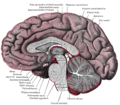Wodociąg mózgu
Wodociąg mózgu (łac. aquaeductus cerebri), zwany także wodociągiem Sylwiusza (od nazwiska Franciszka de le Boë Sylviusa, medyka i uczonego holenderskiego) – kanał w śródmózgowiu o długości 15-20 mm łączący III komorę mózgową w międzymózgowiu z IV komorą, położoną pomiędzy mostem a móżdżkiem. Przez IV komorę połączony z kanałem kręgowym. Przebiega on łukowato pomiędzy blaszką pokrywy a konarami mózgu. Kanał jest pokryty wyściółką otoczoną istotą szarą.
Wodociąg wypełniony jest płynem mózgowo-rdzeniowym. Jego zablokowanie powoduje wodogłowie niekomunikujące, a w efekcie poszerzenie układu komorowego.
Dodatkowe ryciny
Przekrój poprzeczny śródmózgowia w poziomie wzgórków dolnych.
Bibliografia
- Adam Bochenek, Michał Reicher: Anatomia człowieka. Warszawa: Państwowy Zakład Wydawnictw Lekarskich, 1993. ISBN 78-83-200-4251-1.
![]() Przeczytaj ostrzeżenie dotyczące informacji medycznych i pokrewnych zamieszczonych w Wikipedii.
Przeczytaj ostrzeżenie dotyczące informacji medycznych i pokrewnych zamieszczonych w Wikipedii.
Media użyte na tej stronie
The Star of Life, medical symbol used on some ambulances.
Star of Life was designed/created by a National Highway Traffic Safety Administration (US Gov) employee and is thus in the public domain.Autor: unknown, Licencja: CC-BY-SA-3.0
This is a section in the transverse plane through the human midbrain at the level of the superior colliculus, showing the rough path of each nervus oculomotorius from its nucleus toward the eye. The front of the head is near the bottom of the picture.
Axial section through mid-brain. (Schematic.) (Testut.) 1. Corpora quadrigemina. 2. Cerebral aqueduct. 3. Central gray stratum. 4. Interpeduncular space. 5. Sulcus lateralis. 6. Substantia nigra. 7. Red nucleus of tegmentum. 8. Oculomotor nerve, with 8’, its nucleus of origin. a. Lemniscus (in blue) with a’ the medial lemniscus and a" the lateral lemniscus. b. Medial longitudinal fasciculus. c. Raphé. d. Temporopontine fibers. e. Portion of medial lemniscus, which runs to the lentiform nucleus and insula. f. Cerebrospinal fibers. g. Frontopontine fibers.
Drawing of a cast of the ventricular cavities, viewed from the side. (Retzius.)
Star of life, blue version. Represents the Rod of Asclepius, with a snake around it, on a 6-branch star shaped as the cross of 3 thick 3:1 rectangles.
Design:
The logo is basically unicolor, most often a slate or medium blue, but this design uses a slightly lighter shade of blue for the outer outline of the cross, and the outlines of the rod and of the snake. The background is transparent (but the star includes a small inner plain white outline). This makes this image usable and visible on any background, including blue. The light shade of color for the outlines makes the form more visible at smaller resolutions, so that the image can easily be used as an icon.
This SVG file was manually created to specify alignments, to use only integers at the core 192x192 size, to get smooth curves on connection points (without any angle), to make a perfect logo centered in a exact square, to use a more precise geometry for the star and to use slate blue color with slightly lighter outlines on the cross, the rod and snake.
Finally, the SVG file is clean and contains no unnecessary XML elements or attributes, CSS styles or transforms that are usually added silently by common SVG editors (like Sodipodi or Inkscape) and that just pollute the final document, so it just needs the core SVG elements for the rendering. This is why its file size is so small.Scheme showing relations of the ventricles to the surface of the brain.
















